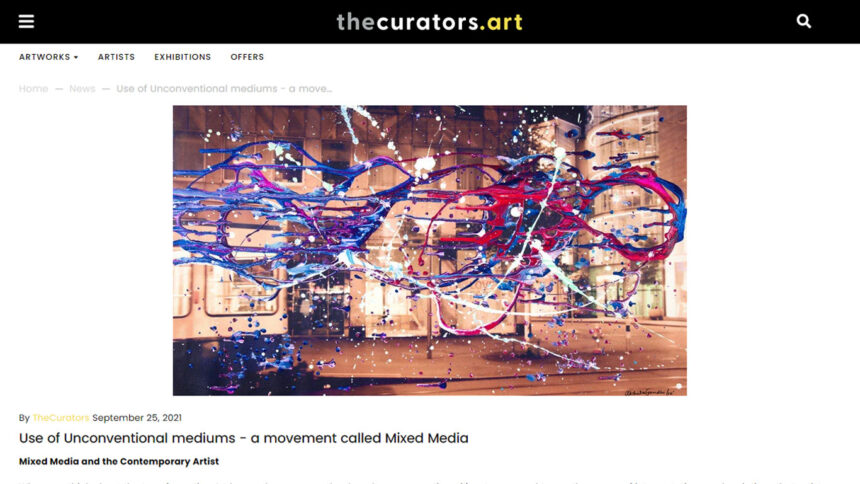Use of Unconventional mediums – a movement called Mixed Media
Mixed Media and the Contemporary Artist
When you think about the transformation Art has undergone over the decades or generations, it’s a true marvel to see the scores of interpretations and variations that artists have imagined. Experimenting with shape, forms, materials, mediums, and subjects, each production, is their attempt to present perspective and provoke thought.
What’s most fascinating about this evolution of art, artist and artistry are the various forms and methods used to manifest this perception into something you can feel and touch. From impressionism, modernism, surrealism, and everything in between, this transformation has not only birthed some of the greatest works of all time but has defined eras and created a pathway for generations to experiment and make it their own.
One such form which has gathered a fair bit of attention for its varied takes and manifestations is ‘mixed media’. It’s been a definitive form that has received innumerable interpretations and is a hot favorite amongst contemporary artists and collectors. And why not? Playing with new and emerging mediums is a hallmark of the contemporary generation.
Its origin and etymology
To understand why mixed media is a favorite amongst artists, especially contemporary ones, you first need to understand, at its most basic level, what this artform entails. In its simplest sense, mixed media art is essentially the combination of different mediums or materials to create one truly unique piece of art.

Pablo Picasso’s 1912 ‘Still Life with Chair Caning’ may be widely considered the first notable appearance of the form. Picasso’s creation combined a collage of textures – an oilcloth with a chair caning design pasted on canvas and a rope that framed the picture, sparked the Cubist Movement. However, many believe that the earliest mixed media artists were from the Byzantine Empire. Artists from this time often featured gold leaves in the many versions of art they had at the time – giving it the signature touch of mixed media art.

From following Picasso as well as Georges Braque, who were known as the fathers of mixed media art, the art form took on a life of its own. From Dadaism to installations, collages and decoupage, artists have played, shaped, and molded their own interpretations. Famed artists like Henry Matisse created his own rendition of the form. The Blue Nudes series that defined the female silhouette with pieces of blue paper cut-outs was one of Matisse’s greatest body of work.
India & Mixed Media Art
From its origins in Europe to its widespread popularity in America and straight to home shores, the allure of mixed media hasn’t evaded Indian artists. It created a movement with renditions of this artform taking over galleries and even the online social blogospheres.

‘Alive’ and ‘Chez Willy Wonka’ by Akshita Gandhi are perfect examples of this understanding. With these two creations, she combines printed canvas with fluid and acrylic paint to create mesmerizing scenes that beautifully capture the concept of time and space.
Another fascinating example is Michelle Poonawalla’s collection which includes works like ‘Desert Rose’ and ‘Forest Flutter’ is an incredible display of modern-day mixed media art. Her body of work includes painting and installations, which combine cutting-edge technology like projection mapping and motion sensors with traditional mediums to create an artistic symphony.

Indian artists have been playing with different mediums both contemporary and traditional to create truly unique artistic dispositions that are signature to not just the form but to their distinct style as well. Presenting unique perspectives and playing with alternative mediums Artists like Santosh Jain’s experiments with digital collages wrapping lens and non-lens-based images with pastels, sequins, gauze, thread and other found material has given a new dimension to art, ‘Journey’ is one such prototype. Revati Sharma Singh’s experiments with unusual materials like sterling silver beads stitched on canvas, work like couplets in ‘Temporal Patterns Fragmented Landscapes’ challenging boundaries and putting India on the global mixed media art scene as well.

Looking back, from where this dynamic artform began to the journey it’s made since then, it’s remarkable to see its adaptations that span across time and geographies. Its malleability and the room for fluidity it provides is perhaps its most valued proposition. And given the insurgence of technology injecting its influence across industries and verticals, Mixed Media is perhaps the most natural home for where we could see the future of modern and contemporary art moving.
In fact, as we settle into the nuances and versatility of Mixed Media Art, what we begin to realize is that experimentation is perhaps the trademark of this artform. Whether it’s melding video with large-scale canvas or layering textures and paint with pop art cut-outs, this medium assuredly invites Artists to color outside the lines and create a truly unique window into their minds. Presenting a smorgasbord of endless possibilities, mixed media art is quite literally the perfect playground for artists, contemporary or otherwise.
Authored by:
Dr Gunjan Shrivastava
Gunjan is a contemporary Artist, Educator with a PhD in Visual Arts and 20 years of experience in the field of art. As an art influencer, she actively supports sustainable artwork and cyanotype was one such technique she adopted to set her foot in being an artist to support and contribute to sustainable art


Leave a Reply